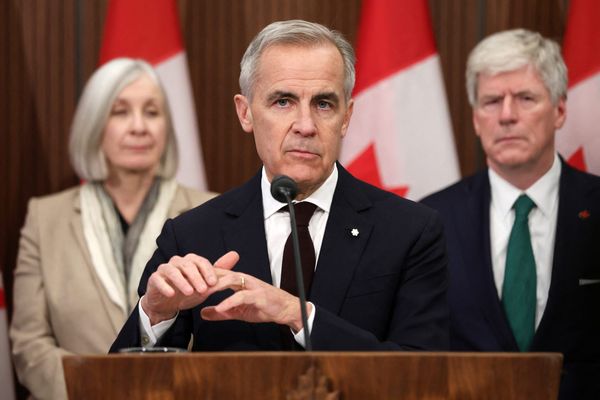
Matthew Russell Lee is staring at three computer monitors, his back turned to the press room entrance of the Southern District of New York courthouse. He prefers this station to his actual cubicle, which is a few feet away, cluttered with spare shirts and notepads. One computer provides unlimited access to PACER, the database of federal court records, which he obsessively refreshes in between firing off tweets from an adjacent laptop. The third screen displays the media page for the United Nations, which banned him from its New York headquarters.
I find Lee at his makeshift desk in the anteroom on Wednesday afternoon, a pile of Halloween candy next to him. He graciously offers me some. He has one ear cocked to a television broadcasting a live feed of the Sam Bankman-Fried trial. Twenty-one floors above us, the FTX founder’s attorney, Mark Cohen, is delivering one final plea to the jury that his client was acting in good faith when he directed $8 billion in customer assets to luxury real estate, venture investments, and risky trades.
Lee offers the best defense of Cohen’s lackluster performance that he can muster.
“Well, it’s not their burden of proof,” he tells me. He's right: It's the prosecution’s responsibility, after all, to prove guilt beyond a reasonable doubt.
The spectacle surrounding Bankman-Fried’s trial proved inevitable, with the meteoric rise and fall of crypto's boy wonder seemingly destined for a Netflix docuseries. Perhaps less expected was the role to be played by Lee's one-man news operation, Inner City Press, which chronicled the trial in real time—tweet after tweet after tweet—for some 183,000 followers.
“The circus is coming to an end,” he tells me, “and not a day too soon.”
‘A funny little world’
Lee’s position in the SDNY press room, tucked away in a forgotten corner on the fifth floor, is a few feet from the front door, walled off from rows of cubicles occupied by mainstream outlets like Reuters and the Associated Press. When you stumble in, he's the first person you see.
The game of court reporting is speed, with wire services rushing to publish reports seconds before their peers. From Lee's post, plugged right into PACER, he frequently beats all of them, though he doesn’t focus as much on articles. Instead, he live-tweets proceedings, listening to audio from nearby televisions and summarizing the proceedings.
Lee has benefited from the arcane rules of SDNY, the storied federal district court made famous by shows like Billions. The stodgy institution doesn't allow reporters to bring electronics into the building, ranging from computers and cellphones to audio recorders and smartwatches. As a result, most dispatches from high-profile trials are delayed as journalists have to run downstairs, collect their devices, and find a perch outside to write. Only a select few who regularly cover the courthouse can gain accreditation, which includes plugged-in workspace in the press room.
Crypto is an industry built around social media, with its acolytes starved for constant updates that mimic the 24/7 markets of the tokens so many feverishly trade. The Bankman-Fried trial has been no exception. Publications like Bloomberg, the New York Times, and the Wall Street Journal recognized that appetite and set up live blogs staffed by teams of reporters, but those outlets all deploy paywalls—and many in crypto don't trust mainstream outlets to begin with.
The guiding principle for Lee’s pirate operation is transparency, which is why he posts directly to X (formerly Twitter) at a frenetic pace, later backfilling in details—and generating income for himself—with a hodgepodge of vlogs, Substack posts, and hastily written e-books.
Crypto Twitter, as the social-media-dwelling blockchain denizens are known, has eaten up his coverage. According to the analytics site Social Blade, Lee added more than 12,000 followers during the trial, often retweeting praise from his new supporters and answering questions about the judicial process. Even with crypto influencers like Tiffany Fong converging on the courthouse, Lee became a go-to source.

One Bitcoin investor, who said he prefers independent reporters to mainstream outlets, told me over DM that he follows Lee because the live tweeting “puts you as close as you can to follow the proceedings.”
Lee seems bemused by the attention, especially after Binance CEO Changpeng “CZ” Zhao shared one of his posts about the trial.
“It’s a funny little world,” Lee says.
Lee himself is not a crypto enthusiast, though he sympathizes with the space. One of the first blockchain-related trials he covered involved Virgil Griffith, a programmer sentenced to 63 months in prison for, among other crimes, attending a crypto conference in North Korea.
While prosecutors have painted Bankman-Fried as a traditional fraudster who was apathetic about crypto’s ethos of decentralization, Lee views Griffith differently—as a true-believer libertarian.
“It’s an idea I can respect, although I don’t totally endorse it,” Lee tells me. “There’s some interplay between this idea of openness of courts and institutions, and by the same token, a certain freedom of individuals to not be entirely monitored.”
‘An audience of two’
Lee has not always focused on SDNY, although the courthouse is where he spends most of his time now. Inner City Press began as a mimeographed broadsheet in 1987, with his crusades shifting over the years from predatory banking to court transparency.
His unusual approach has earned him a number of media profiles over the years, from the New Yorker to BuzzFeed News, though his last moment of fame—or infamy, depending on who’s talking—came in 2018.
Lee was covering the United Nations full-time, positioning himself as an old-fashioned muckraker embedded amid a stuffy press corps of foreign correspondents. He broke major stories about excess spending, but his aggressive tactics alienated both his reporting colleagues and U.N. personnel, who complained about his antagonistic attitude and junk-filled workstation.
After several incidents of alleged harassment, culminating in a physical altercation with a security officer, the U.N. revoked Lee’s media credentials and barred him from the premises. Lee continues to frame the ban as a First Amendment issue, made complicated by the fact that the U.N. operates outside U.S. law.
Stéphane Dujarric, the spokesman for the U.N. secretary-general, tells me that Lee’s prohibition has nothing to do with his coverage. “It’s basic human behavior, and he violated those rules,” Dujarric says. “He was creating an unsafe environment.”
Lee admits that his philosophy of accountability journalism led him to be dismissive of other reporters, many of whom just bounce between flashy events and provide surface-level coverage at the expense of ignoring more humdrum stories that desperately need attention, like bail hearings. He tells me that he’s since “gotten over himself.”
Covering SDNY seems to have tempered his attitude. Now in his late fifties, Lee still runs around the building like a madman, taking advantage of every 15-minute break to pop down to the seldom-visited magistrate court, where new defendants are brought in for arraignment.
“It has only an audience of one, which is the judge,” he tells me. “So, I try to say, ‘At least there should be an audience of two.’”
Lee seems to have won fans throughout the building, cracking jokes with every security officer and translator we encounter rushing from floor to floor.
When I ask a guard at the metal detector if he knows Inner City Press, he shakes his head before a grin fills his face in recognition.
“Oh, Matthew Lee? Quiet guy,” he says. “Well, gregarious,” he adds, acknowledging Lee’s rapid-fire manner of speaking that evokes a 1920s radio host. “But a quiet personality.”
Bankman-Fried’s trial may be winding down, but for those hanging on Lee's every tweet, there will be no shortage of crypto cases to cover. His current mission is finding pro bono counsel to help him appeal the sealing of another fraud case at SDNY.
“I wish there were 10 people doing this work,” he says.







